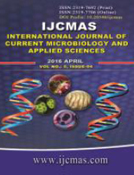


 National Academy of Agricultural Sciences (NAAS)
National Academy of Agricultural Sciences (NAAS)

|
PRINT ISSN : 2319-7692
Online ISSN : 2319-7706 Issues : 12 per year Publisher : Excellent Publishers Email : editorijcmas@gmail.com / submit@ijcmas.com Editor-in-chief: Dr.M.Prakash Index Copernicus ICV 2018: 95.39 NAAS RATING 2020: 5.38 |
In the present observation biosystematics of three species of Boraginaceae viz., of Heliotropium indicum, Trichodesma indicum and Trichodesma zeylanicum was studied. All the three species showed a marked difference in leaf and inflorescence morphology, stomatal behaviour, epidermal trichome, pollen grain characteristics and stem anatomy, hypodromous and brochidodromous venation of their leaves. Leaves were landeolate to ovate. The inflorescence colour was pale blue to white. Length of inflorescence was found to be 4.0 to 6.5. The stomatal Index in these three species varied greatly. T. indicum and T. zeylanicum showed anomocytic stomata with 16mm in length and 12mm width and Stomatal Index was 34.88 and 44.68 respectively. Heliotropium indicum exhibited anisocytic stomata which were 12mm long and 10mm wide. The Stomatal Index was 32.65. All the three species showed the presence of unicellular glandular hairs which differed in forms. All the three species showed tricolpate pollen grains, but differed in their form and size. All the three species showed more or less similar stem anatomical features with differences only in their hypodermal layers. Numerical analysis with reference to morphological, stomatal, pollen grains, trichomes, stem anatomy and stomatal index was carried out for 31 characters. It was found that Heliotropium indicum showed similarity with Trichodesma indicum in only eight characters and with Trichodesma zeylanica in only nine charaters. Trichodesma indicum and T. zeylanicum showed resemblances in twenty two characters. On the basis of matching coefficient it was observed that Heliotropium indicum showed only 25.80% resemblance with T. indicum, and 29.03% with T. zeylanicum.Trichodesma indicum and T. zeylanicum showed 70.96% resemblances, and therefore might be considered as same species of the genus Trichodesma.
 |
 |
 |
 |
 |